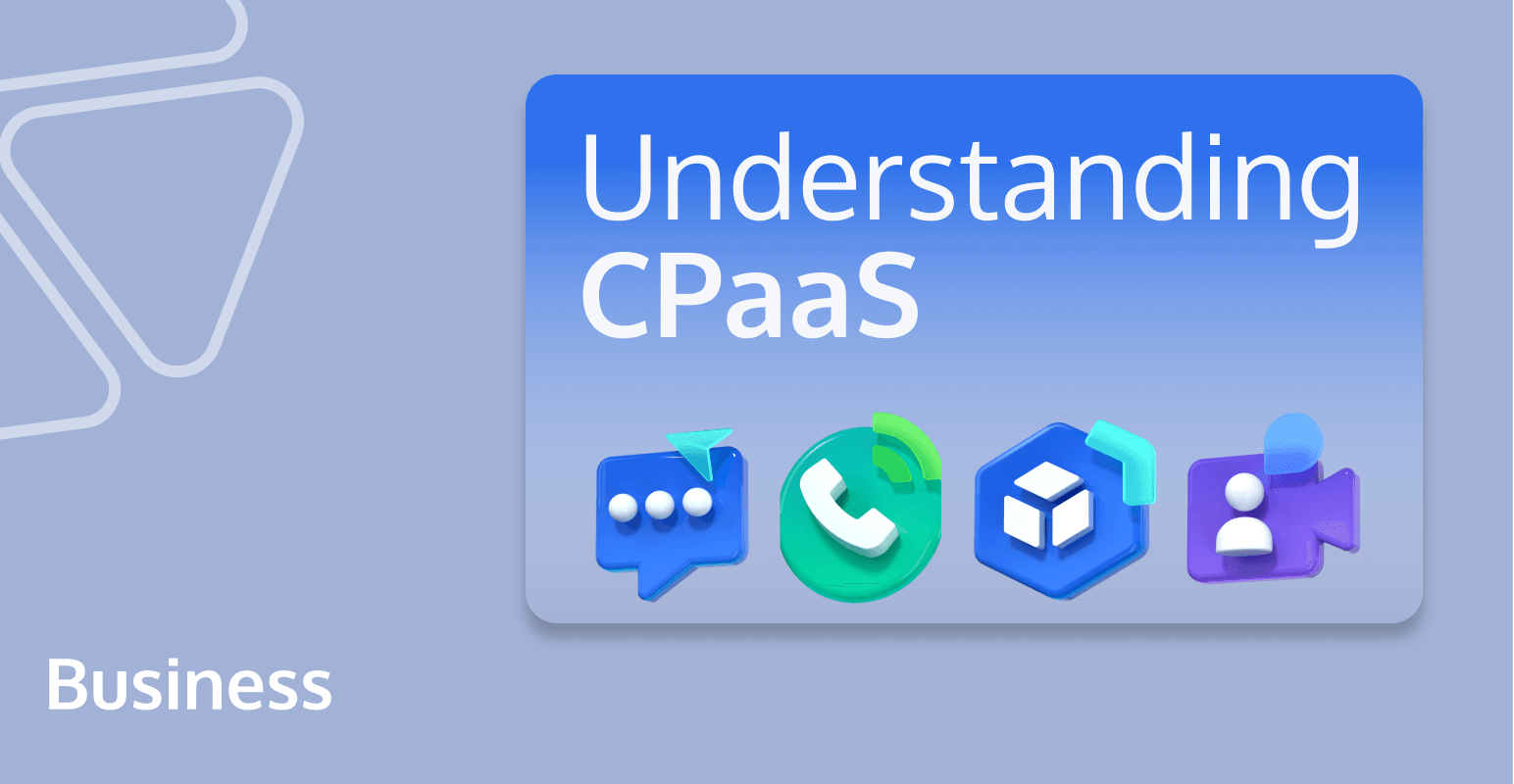
CPaaS, short for Communications Platform as a Service, is a cloud-based platform that enables developers to integrate real-time communication features, such as voice calling, text messaging, and video conferencing, into their own applications or services. It acts as a facilitator, eliminating the need for developers to build complex communication infrastructure from scratch, saving time and resources.
In short, CPaaS allows you to bypass complex infrastructure building, enabling you to create your own "WhatsApp" or "FaceTime" or seamlessly integrate real-time communication into your app in the shortest time possible. It's the ideal choice for developers with basic coding knowledge or companies seeking mature and ready communication results with limited resources.
Benefits of Using CPaaS

CPaaS providers offer developers a comprehensive set of Application Programming Interfaces (APIs), SDKs (Software Development Kits), and developer tools to embed various communication functionalities into their applications seamlessly. Here's a glimpse of advantages of using CPaaS:
- Instantly Accessible Infrastructure:
CPaaS providers offer a ready-made infrastructure, usually hosted in the cloud, allowing developers to leverage existing systems without worrying about hardware, maintenance, or scalability. This significantly reduces the time and cost required to develop and deploy communication-based applications. - Communication APIs:
CPaaS providers expose a variety of APIs, enabling developers to integrate voice, SMS, video, chat, and other communication channels into their applications. These APIs provide a standardized approach, often with extensive documentation and sample code, making it easier for developers to incorporate communication features. - Flexibility and Customization:
CPaaS platforms offer a range of customization options, allowing developers to create personalized communication experiences tailored to their application's specific requirements. From branding and interface design to advanced functionalities, developers have the freedom to tailor the user experience as per their needs. - Scalability and Reliability:
With CPaaS, scalability is never a concern. Developers can easily accommodate changing communication needs, whether it's handling hundreds or millions of users. Additionally, CPaaS providers often offer robust infrastructure and redundant systems, ensuring reliable and uninterrupted communication services. - Analytics and Reporting:
CPaaS solutions often come equipped with analytics and reporting tools, enabling developers and businesses to gain valuable insights into real-time communication data. This information helps optimize communication strategies, identify usage patterns, and enhance the overall user experience.
CPaaS vs. UCaaS
People often find themselves in a maze when it comes to CPaaS and UCaaS. Distinguishing between these two services is vital because their practical applications can vary significantly. Let's unravel the confusion by exploring the key aspects that set them apart:
UCaaS (Unified Communications as a Service)
- Internal focus for businesses
- All-in-one solution for team communication
- Enhances collaboration within organizations
CPaaS (Communication Platform as a Service)
- External focus for developers and businesses
- Tools to integrate communication features into apps
- Enhances customer engagement on external platforms
CPaaS Use Cases
- Streamlining Customer Support:
In the age of instant gratification, customers expect quick and effective support. CPaaS enables businesses to integrate messaging, voice, and video functionalities seamlessly into their existing customer support systems. By leveraging CPaaS, businesses can provide real-time customer support, automate responses through chatbots, and even offer video consultations - all from a unified platform. - Transforming Marketing Campaigns:
Traditional marketing campaigns can be one-sided, with limited interaction. CPaaS breathes new life into marketing efforts by enabling interactive and personalized experiences. Through SMS campaigns, businesses can send targeted messages with an embedded link for immediate action. Voice API integrations offer the option for users to respond vocally, increasing engagement and conversion rates. With CPaaS, marketing becomes a two-way conversation. - Facilitating Remote Collaboration:
In an increasingly remote work environment, effective collaboration becomes more vital than ever. CPaaS platforms allow businesses to integrate voice and video conferencing capabilities into their existing collaboration tools. Team members can connect seamlessly, share screens, and collaborate on projects in real-time. CPaaS enables uninterrupted communication, fostering productivity and teamwork regardless of geographical barriers. - Enhancing E-commerce Experiences:
CPaaS brings an exceptional level of engagement to e-commerce platforms. By integrating voice and video chat options during the customer buying journey, businesses can offer customers instant assistance, personalized recommendations, and even virtual product demos. With CPaaS, e-commerce can transform into an interactive and immersive experience, driving customer satisfaction and boosting sales. - Building Secure Verification Systems:
Protecting confidential user information is a top priority for businesses. Thankfully, CPaaS offers robust security features that can streamline verification processes. By integrating CPaaS into password recovery or account verification systems, businesses can implement two-factor authentication via SMS or voice calls. This enhances security while delivering a seamless user experience, reducing the risk of unauthorized access. - Powering IoT Connectivity:
The Internet of Things (IoT) is transforming various industries, and CPaaS plays a crucial role in connecting devices seamlessly. With CPaaS, businesses can create IoT applications that facilitate communication between devices, sensors, and control systems. This opens up possibilities for innovative solutions, including smart homes, industrial automation, and predictive maintenance.
The Gartner Recognized CPaaS Vendor You Should Choose
Gartner, a premier research and advisory company, has acknowledged Tencent RTC's ability to execute and the completeness of its vision in the Communication Platform as a Service (CPaaS) market. This recognition is a testament to Tencent RTC's commitment towards delivering cutting-edge communication solutions that are not only reliable but also innovative.
Furthermore, Tencent RTC's being ranked the highest in Asia in the Video Use Case in the Critical Capabilities report for CPaaS. This ranking underscores our ability to stand out on a global scale with advanced and innovative communication solutions.
Take a Look at Our Products
In Tencent RTC, we offer a strong set of apis and sdks to ensure seamless and efficient communication for businesses worldwide. Our CPaaS solutions include:
Tencent RTC Call
Seamlessly incorporate our call APIs into your web, mobile, or desktop applications, paving the way for an effortless integration of both one-to-one and group audio/video call features.
Tencent RTC Conference
Our conference solution presents a comprehensive array of features, encompassing room management, screen sharing, participant control, microphone management, and even essential beauty filters.
In addition, we offer open-source UIKits equipped with user interfaces, facilitating effortless integration and customization of audio and video rooms.
Tencent RTC Chat
Experience an interactive and immersive chat with our social features and diverse media types. Our solution ensures that the conversation continues even when users are offline, thanks to our offline push functionality.
We cater to your extensive community needs by providing super large community groups that can host up to 1 million members. Our platform supports various group types, including work, public, meeting, audio-video, and community groups.
RTC Engine
Seamlessly integrate our all-in-one SDK into your applications to unlock a host of advanced features. This includes voice and video calling, live broadcasting, and interactive streaming. Our comprehensive SDK is designed to enhance your application’s capabilities, offering your users a rich and engaging communication experience.
In-Game Voice Chat
Our unique spatial audio technology introduces a virtual stereo sense for listeners, crafting a 3D immersive experience, and enable players to communicate based on their in-game proximity. Experience realistic interactions like never before, and bring your virtual world to life.
Conclusion
CPaaS has opened up a world of possibilities for developers to incorporate communication functionalities seamlessly into their applications. By streamlining the development process, CPaaS enables businesses to enhance customer interactions, increase efficiency, and drive innovation.
Tencent RTC specializes in providing global enterprises with cutting-edge real-time communication solutions, Our expertise and innovative mindset have made us pioneers in the CPaaS industry.
If you have any questions or need assistance, our support team is always ready to help. Please feel free to Contact Us or join us in Discord.


